Kyushu’s four largest cities
Home to volcanic landscapes, rich history and amazing food, Kyushu has a huge amount to offer visitors willing to cover the distance from better known destinations on Honshu, yet remains a part of Japan that relatively few foreign tourists make it to. With easier access to local information than ever before and speedier transport options than many realize - not to mention the growing attraction of going "off the beaten track" - Japan's third largest island feels due for something of a reappraisal.
In a nod to the classic ügGolden Routeüh of Tokyo, Hakone, Mt Fuji and Kyoto that has served countless visitors to the country, for this video project I set out to introduce an alternative routing covering Kyushu's four biggest cities - a Golden Route to West Japan. Over the course of four exciting days, I worked my way from Kagoshima - a historic city in a spectacular, subtropical setting - through Kumamoto and Fukuoka, ending with Kitakyushu and the Kanmon Strait separating the island from its larger neighbor to the east.

Day 1 - Kagoshima City
My time in Kyushu began close to its southern tip in Kagoshima. A historic city in a spectacular, subtropical setting, Kagoshima is often compared to its sister city of Naples, Italy, due to its climate, laid back atmosphere and of course, the beautiful and very active volcano of Sakurajima that looms over the city from across the bay and regularly sends plumes of smoke and ash into the air.
After arriving by shinkansen into the main station of Kagoshima Chuo, I jumped on a tourist loop bus heading west and just outside the city center to SENGAN-EN - a traditional landscape garden known both for its beauty and its connection to Kagoshima's erstwhile rulers - the Shimadzu Clan.
Inside, visitors can explore a series of beautiful, interconnected spaces, with giant stone lanterns, bamboo groves, flowing streams and small shrines. In common with other traditional gardens, Sengan-en uses the technique of borrowed scenery to draw elements from the surrounding landscape into its own scenery - in this case, the spectacular form of Mount Sakurajima rising up from across the bay. Sadly, on the day of my visit the volcano was largely hidden by mist.

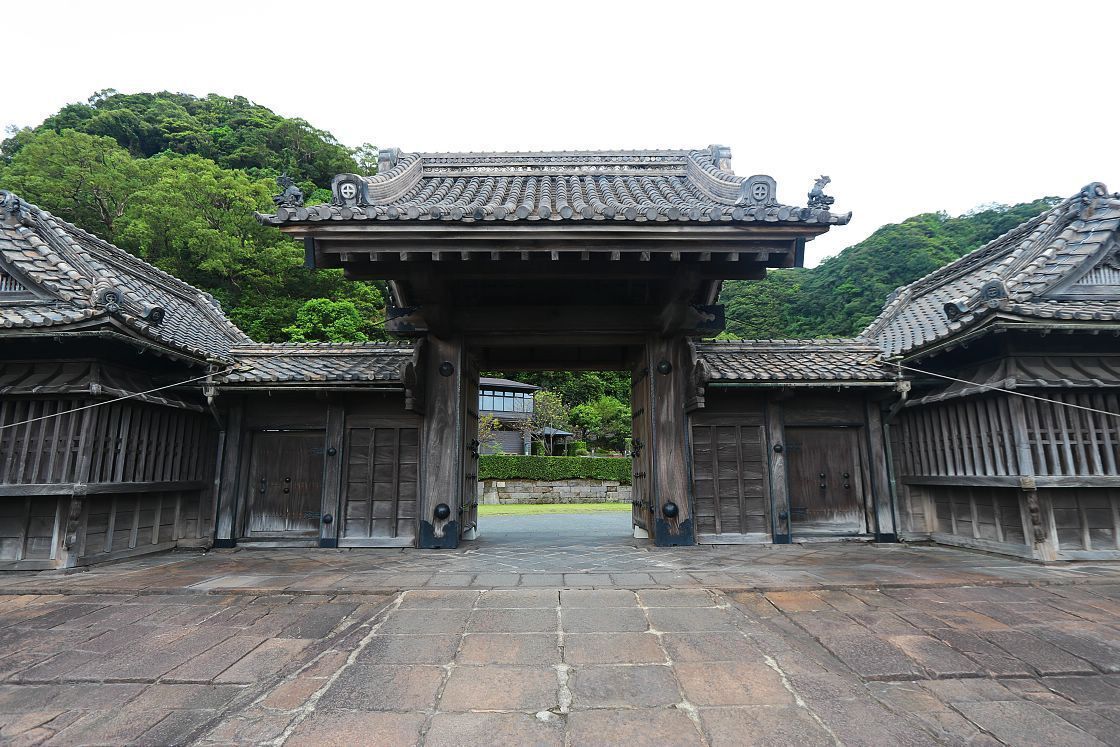


Dotted in and around the garden are the remains of an early industrial complex, built in the mid-19th century. Using a combination of indegenous Japanese technology and techniques learned from Dutch texts, the facility produced iron destined for use in steamships and cannon building.
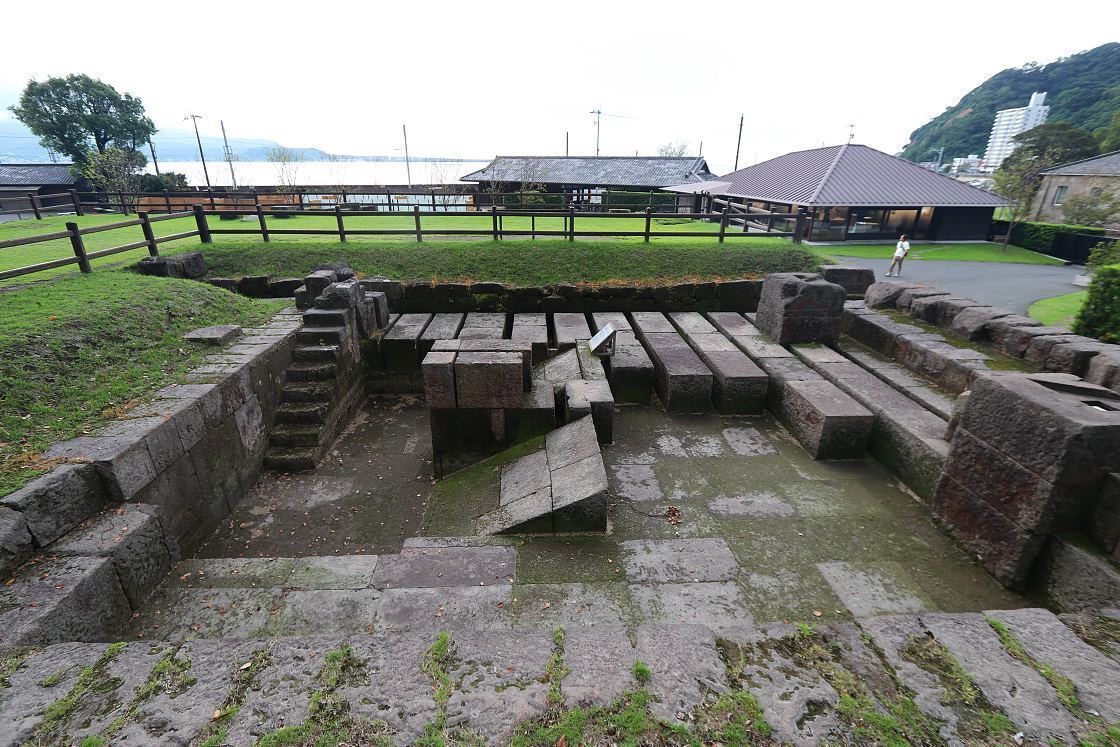

Standing just outside the main entrance to the garden and covered by the same admission ticket is the SHOKO SHUSEIKAN - a museum dedicated to the history of the Shimadzu Clan, set inside an attractively preserved former factory building, the oldest of its kind in Japan.

One of the longest running and most successful samurai families, the Shimadzu Clan ruled over southern Kyushu - a prosperous territory with rare overseas connections, whose distance from the shogun's own power base in what is today also provided an unusual degree of independence. Especially towards the turbulent closing years of the Edo Period (1603-1868), the domain produced many influential figures who would ultimately change the course of Japanese history.



Leaving the garden and museum behind, I jumped back on the loop bus for a 20-minute ride southwest along the coast to Kagoshima Port. Here, I changed to the SAKURAJIMA FERRY for a pleasant - although rainy and somewhat overcast - cruise across the bay. The ferry takes just 15 minutes to cross and runs for 24 hours a day, serving the several thousand residents living on and around the mountain.

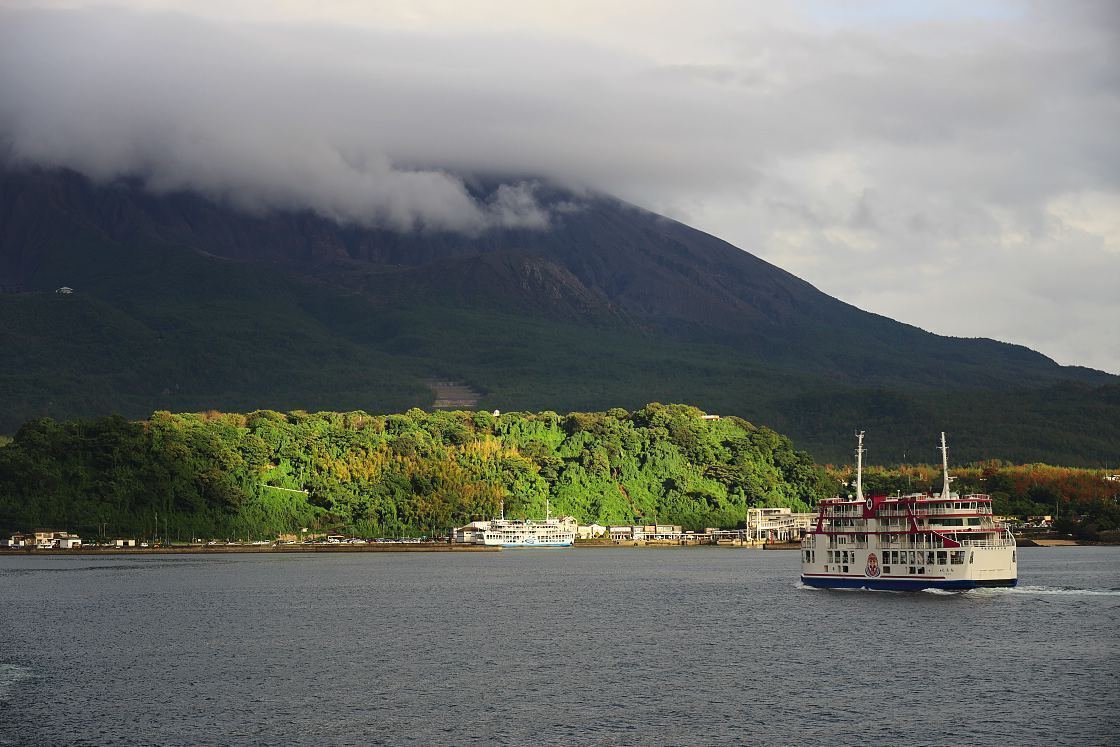
There are a few different ways to take in Kagoshima's most iconic view, with a number of observation points dotted around the base of the mountain, but today I would be experiencing it from sea level, on a private sea kayaking tour. Six minutes' walk from the port, I met my guide at the nearby Sakurajima Rainbow Hotel. From here, we set off together in his car to our launch point, located over at the southern edge of the mountain's base.
After a quick review of the safety basics and paddling techniques, it was at last time to push off into the little inlet, but no sooner had I entered the water than the sky began to darken overhead and a light film of raindrops began to patter on and around my little boat.

Signs of volcanic activity were visible all around as I followed my guide out of the little inlet and into the bay, with jagged tendrils of black, volcanic rock reaching into the water and breaking up the smooth lines of the shore. I even began to notice small pieces of light, porous pumice stone floating nearby. Hugging the coast, we continued around the mountain in a clockwise direction until the graceful curve of Sakurajima loomed once again into view.


After taking a little longer to enjoy the water and the spectacular view, it was time to make our way leisurely back to shore. On the way, my guide led me onto a beach of fine, soft black sand - another eye opening moment and the perfect place to bring the day to a close.
Day 2 - Kumamoto City
The next day, a 45 minute shinkansen ride brought me to Kumamoto, another historic city known especially for its magnificent castle. Despite being quite severely impacted by a series of earthquakes back in 2016, the city has made a heroic recovery and today feels as vibrant and exciting as ever.
Arriving into the modern and attractively designed station, I changed to a tram for a quick 15 minute ride to what is surely the city's best known and most iconic structure - KUMAMOTO CASTLE. Before going inside, however, I made a stop at the little tourist market located close to the entrance and styled after an old castle town, called SAKURANOBABA JOSAIEN.

In addition to tickets for the castle itself, shops and stalls within the market offer the usual selection of cute souvenirs as well as a few popular local delicacies in snack-sized form. Keen to give them a try, I ordered Karashi Renkon - deep fried slices of lotus root stuffed with a peppery mix of miso and Japanese mustard - and basashi sushi, with a slice of raw horse meat instead of fish on a bite sized mound of rice.


Next, it was time to visit the castle itself - undoubtedly one of the most impressive castles in all of Japan and a beloved symbol of Kumamoto. Built in the early 17th century, it was long considered impregnable due to its sheer scale, strategic design and its formidable defensive walls, nicknamed "Musha Gaeshi" or warrior repellent.

Sadly, the castle was badly damaged in the 2016 earthquakes and still bears many scars, from missing chunks of masonry or collapsed sections of wall to whole towers reduced to rubble. Today, spirited reconstruction efforts continue throughout the castle grounds, however despite the graceful main tower reopening in 2021, it will be many more years before the entire complex has been fully restored.
One feature of the repairs that can in fact work to visitors' benefit is the long, elevated walkway some six meters above ground, providing a temporary route from the entrance to the main tower, allowing construction work to continue unhindered while creating a number of new and interesting perspectives on the castle's various buildings and defenses. Built from cypress sourced within the prefecture and with a surprisingly aesthetic design, the passage has the look and feel of something that was always intended to be here.

At the heart of the castle is its main keep - an elegant, double-towered structure with black painted walls and gracefully sloping roofs. Due to the remarkable repair work, the exterior shows barely a trace of the damage sustained during the earthwork, although some of the numbers given to individual stones in the foundation wall so that each could be returned to their original place have been left in testimony to the great efforts involved.



Inside, visitors pass a series of well-presented exhibits covering the castle's history and construction on the way up to the top floor observation deck. For me, a particular favorite was the scale models of the keep itself, with cutaways revealing interior details and the intricate lattice of beams supporting the structure from inside.



After taking in the view from the top of the main keep, it was time to move on to my next stop of the day at SUIZENJI JOJUEN GARDEN, a traditional landscape garden a little way southwest of the city center, and a 15 minute ride from the castle by tram.
Originally built as the grounds for a temple in the early 1600s, it was later transformed by the ruling Hosokawa Clan first into a teahouse and later into a classical strolling garden with an elegant, geometric style. Making one's way around it, circling a large central pond fed naturally by springs connected all the way to Mount Aso, is a little like stepping into an imaginary landscape with stylized little forests and rolling hills.



Also within the grounds of the garden stand a number of buildings, including the Izumi Shrine, built in 1878, one year after rebels burnt down much of the city, including a teahouse that once occupied the same space. Close to the opposite shore is a 400 year old thatched building brought piece by piece from the Imperial Palace in Kyoto in 1912 to replace the teahouse that was destroyed.


Moving on from the garden, I jumped on another tram at the nearby Suizenji Park stop for another 15-minute ride back into the city center. Here, my final stop for the day was at the KUMAMOTO YATAIMURA - a narrow, lantern-lit alley lined on both sides with 18 food stalls or yatai, each offering some of the city's favorite dishes in a relaxed setting, with no more than sixteen seats to each vendor for an authentically cozy experience.

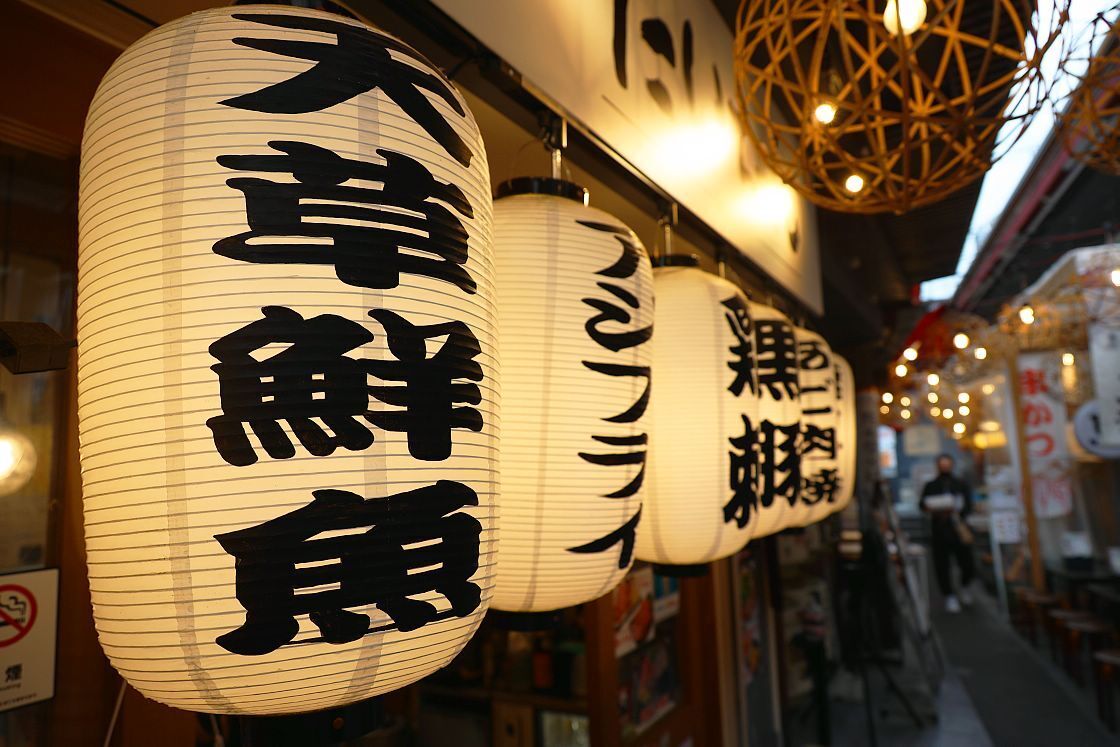

Making my way around, I started with a plate of stir fried pork, called agonikuyaki, followed by some yakitori skewers and finally okonomiyaki - often described as like a savory pancake - generously topped with grilled seafood and lashings of tangy sauce.



Day 3 - Fukuoka City
I began the third day of my time in Kyushu on the Kitazaki Coast, an oasis of tranquil countryside and sandy beach along roughly the eastern half of the Itoshima Peninsula, a little way northwest of central Fukuoka.
My accommodation for the night had been the SEVEN X SEVEN ITOSHIMA - a new luxury hotel built in early 2024, matching its attractive coastal setting with airy, minimal decor and terraces attached to each of its guest rooms looking out over the nearby beach.


Tearing myself away from my room - a beautifully furnished suite with stunning views out to sea and more features than I quite knew what to do with, I set out to explore the surrounding coast before making my way later into Fukuoka city center. Conveniently, the hotel also offers rental e-bikes - mine a sleek, expensive-looking model by Specialized - allowing guests the freedom to take in the scenery without having to wear themselves out.


After taking an easy ride along the coast, I worked my way back towards the hotel with just enough time for a quick pit stop for coffee and a delicious maple pancake at the SURFSIDE CAFE, a pleasant beachside spot from whose terrace the view could easily be mistaken for Hawaii. Dropping off my rental e-bike - I really must get myself one of those, I thought - I jumped on a local bus to Kyudai-Gakkentoshi Station and changed to the Chikuhi Line for Gion Station in central Fukuoka.


A lively, laid back city and the largest in Kyushu, Fukuoka was formed over a century ago from a merger of the castle town of the same name with the port town of Hakata. Hakata lives on, meanwhile, both as the name of the main railway station, and a central district alongside the Naka River, to which I was now headed. Here, my next visit was at a teahouse and arts center called HAKATA GEIDOKORO WANOKA, owned by a former geisha and offering a range of traditional performances.
Taking a seat in a beautifully decorated upstairs room, I watched, quite dazzled, as a young Hakata maiko performed a series of traditional dances to songs on the traditional three-stringed shamisen played by the owner herself.
Although commonly associated with Kyoto, geisha can be found in cities throughout Japan. Although quite reduced in number compared with their heyday, today's Hakata geisha draw on a long and well-respected tradition, once widely known for their confident demeanor and spirited performances.


In my case, the experience at Wanoka came bundled with a beautifully prepared traditional lunch, served downstairs in a little bar area and packed into a red lacquered lunchbox. This turned out to be delicious, and the perfect way to wind down after the performance while chatting with the owner.

For my last stop in this part of town, I dropped by KADOTA CHOCHIN TEN, a maker of traditional paper lanterns with a history of 130 years, located in the nearby Kawabata Shopping Arcade. As well as browsing a range of colorful and often unique lanterns, visitors to this atmospheric shop can sometimes find the master himself at work, and even join in with a range of handcrafting activities. Overseas shipping is also available for visitors short on luggage space!


As night fell on the city, I made my way over to the harborside Nagahama area where the day's excited buzz was already giving way to a more laid back atmosphere. Rounding off my time in Fukuoka, I was here to experience another beloved local activity - eating and drinking at one of the city's many yatai or street food stalls.

Once a common sight throughout Japan, yatai have since largely disappeared with central Fukuoka being a rare exception. For that night's meal, I chose DOGENYA - a typical stand with eight seats, offering a range of local favorites with a warm and hearty atmosphere. Here, the main highlights for me was Hakata ramen - thin noodles served in a rich and creamy pork bone broth.


Day 4 - Kitakyushu City
I spent the final day of my trip in Kitakyushu - a city at Kyushu's northern tip and the gateway between Japan's first and third largest islands. Although best known today as an industrial center and transport hub, the city also boasts a number of interesting attractions, with my focus for the day being Moji.
As one of Japan's most important shipping ports, Moji had a vital role to play in the country's early industrialization, serving as a gateway not just for freight, but for western ideas, art and design - the latter still reflected today in the district's nostalgic, early 20th century atmosphere and some especially eye-catching architecture mixing European and Japanese elements.
Upon arrival, the first item on my itinerary was MOJIKO STATION itself - one of Japan's oldest and most atmospheric train stations. From the platform to the main building, which dates to 1914, the station preserves many of its original elements while making clever use of recycled materials for more recent additions.



Just a few steps from the station entrance are two more iconic buildings from the early 20th century: the OLD MITSUI OSK LINES BUILDING - an office and passenger waiting lounge for a major shipping company, whose distinctive octagonal tower once made it the tallest building in the city - and the former MOJI MITSUI CLUB, which once hosted Albert Einstein on a 1922 tour of Japan and boasts a very European timber frame facade.
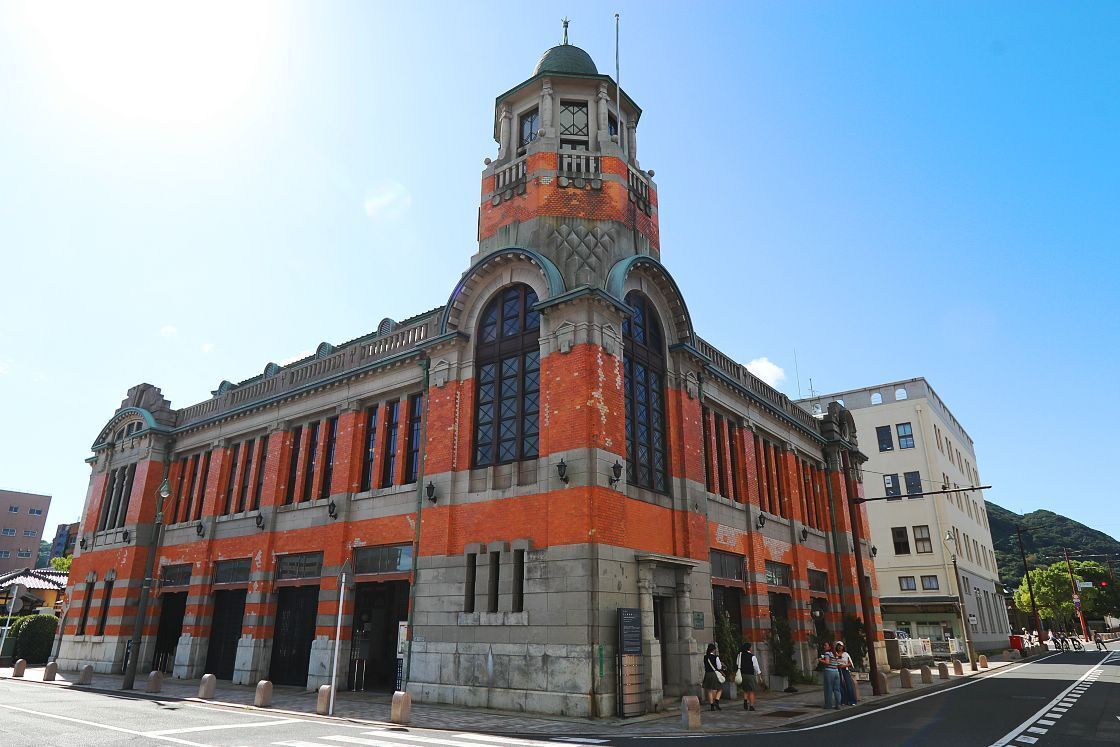

After a brief stroll along the waterfront at the Mojiko Harbor, it was time to start thinking about lunch. Located on the upper floor of a compact building facing out across the strait, CURRY HONPO MOJIKO RETRO is a cozy, welcoming restaurant specializing in the popular local dish of yaki kare or baked curry. Apart from being baked in an oven, what separates this from regular Japanese curry is the addition of melted cheese and a soft boiled egg, adding an even richer taste to the spicy sauce.


For the second part of my day, I made my way a little north of the harbor to JOYiNT MOJIKO, a nearby rent-a-cycle store. Kitted out with an e-bike and helmet, I took a gentle ride north along the coast towards the cape, from where the vast Kanmon Bridge loomed impressively across the strait. It's a sight especially worth seeing on August 13, when an annual firework display - the only one in Japan to take place over a strait or prefectural border - lights up the sky overhead.


Arriving at last at Kyushu's very northern tip, I brought my four-day trip to a close at the MEKARI SHRINE. Said to have existed since ancient times, this small but enormously atmospheric Shinto Shrine sits in the shadow of the Kanmon Bridge, directly overlooking the fast-flowing waters of the strait.
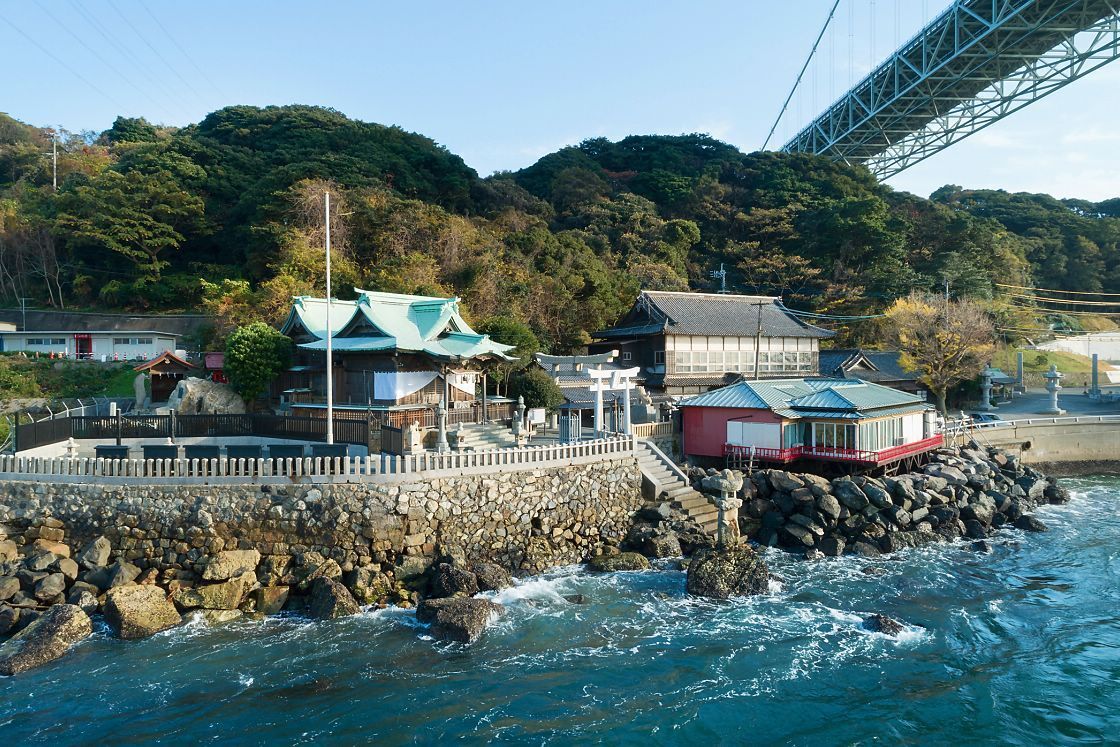

Dedicated to a god associated with purification, the moon and the ebb and flow of tides, the shrine centers on a large sacred rock set into a cliff face beside the small main building. Another highlight is the shrine's reception building, a recent addition with a very appealing mix of traditional and modern minimalist elements.


Towering over the shrine, the Kanmon Bridge extends over a kilometer across the strait, connecting Kitakyushu to the city of Shimonoseki on the opposite side, placing it within the 50 largest suspension bridges in the world. It is not the only way across, however - passing some 60 meters directly underneath the shrine, the 780 meter long Kanmon Tunnel Footpath allows travelers and commuters to make their way across on foot.


Discover More
Click here to visit the official Golden Route to West Japan tour website.
Click below for detailed sightseeing information on each municipality:
